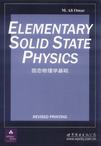固态物理学基础
出版时间:2011-6 出版社:世界图书出版公司 作者:马尔 页数:669
内容概要
《固态物理学基础》是一部优秀的介绍固态物理学入门类书籍,也是一本很好的本科生教材。本书是1975年版本的修订版,在原来的基础上做了不少改进。内容安排结构紧凑,合理,逻辑性强。尽管本书出版的比较早,但不失经典,覆盖面广,囊括了许多读者了解的话题,如,半导体设备和议题,液态晶体,聚合体和一些生物分子。大量的实用案例是本书的一大特色,更加增强了本书的可读性。目次:晶体结构和原子间作用力;x射线,中子和晶体中的电子偏移;格振动:热力学,声学和光学性质;金属ⅰ:自由电子模型;金属ⅱ:固体中的能级;半导体ⅰ:理论;半导体ⅱ:设备;电介体和固体的光学性质;磁性和磁共振;超导体;冶金学议题和固体中的缺陷;材料和固态化学;固态生物化学。附录:量子力学基础。
读者对象:物理,应用物理专业的本科生,研究生以及相关工程领域的科研人员。
作者简介
作者:(美)奥马尔
书籍目录
chapter 1 crystal structures and interatomic forces
1.1 introduction
1.2 the crystalline state
1.3 basic definitions
1.4 the fourteen bravais lattices and the seven crystal
systems
1.5 elements of symmetry
1.6 nomenclature of crystal directions and crystal planes; miller
indices
1.7 examples of simple crystal structures
1.8 amorphous solids and liquids
1.9 interatomic forces
1.10 types of bonding
chapter 2 x-ray, neutron, and electron diffraction in
crystals
2.1 introduction
2.2 generation and absorption of x-rays
2.3 bragg's law
2.4 scattering from an atom
2.5 scattering from a crystal
2.6 the reciprocal lattice and x-ray diffraction
2.7 the diffraction condition and bragg's law
2.8 scattering from liquids
2.9 experimental techniques
2.10 other x-ray applications in solid-state physics
2.11 neutron diffraction
2.12 electron diffraction
chapter 3 lattice vibrations: thermal, acoustic, and optical
properties
3.1 introduction
3.2 elastic waves
3.3 enumeration of modes; density of states of a continuous
medium
3.4 specific heat: models of einstein and debye
3.5 the phonon
3.6 lattice waves
3.7 density of states of a lattice
3.8 specific heat: exact theory
3.9 thermal conductivity
3.10 scattering of x-rays, neutrons, and light by phonons
3.11 microwave ultrasonics
3.12 lattice optical properties in the infrared
chapter 4 metals i: the free. electron model
4.1 introduction
4.2 conduction electrons
4.3 the free-electron gas
4.4 electrical conductivity
4.5 electrical resistivity versus temperature
4.6 heat capacity of conduction electrons
4.7 the fermi surface
4.8 electrical conductivity; effects of the fermi surface
4.9 thermal conductivity in metals
4.10 motion in a magnetic field: cyclotron resonance and the hall
effect
4.11 the ac conductivity and optical properties
4.12 thermionic emission
4.13 failure of the free-electron model
chapter 5 metals il: energy bands in solids
5.1 introduction
5.2 energy spectra in atoms, molecules, and solids
5.3 energy bands in solids; the bloch theorem
5.4 band symmetry in k-space; brillouin zones
5.5 number of states in the band
5.6 the nearly-free-electron model
5.7 the energy gap and the bragg reflection
5.8 the tight-binding model
5.9 calculations of energy bands
5.10 metals, insulators, and semiconductors
5.11 density of states
5.12 the fermi surface
5.13 velocity of the bloch electron
5.14 electron dynamics in an electric field
5.15 the dynamical effective mass
5.16 momentum, crystal momentum, and physical origin of the
effective mass
5.17 the hole
5.18 electrical conductivity
5.19 electron dynamics in a magnetic field: cyclotron resonance
and the hall effect
5.20 experimental methods in determination of band structure
5.21 limit of the band theory; metal-insulator transition
chapter 6 semiconductors i: theory
6.1 introduction
6.2 crystal structure and bonding
6.3 band structure
6.4 carrier concentration; intrinsic semiconductors
6.5 impurity states
6.6 semiconductor statistics
6.7 electrical conductivity; mobility
6.8 magnetic field effects: cyclotron resonance and hall
effect
6.9 band structure of real semiconductors
6.10 high electric field and hot electrons
6.11 the gunn effect
6.12 optical properties: absorption processes
6.13 photoconductivity
6.14 luminescence
6.15 other optical effects
6.16 sound-wave amplification (acoustoelectric effect)
6.17 diffusion
chapter 7 semiconductors ii: devices
7.1 introduction
7.2 the p-n junction: the rectifier
7.3 the p-n junction: the junction itself
7.4 the junction transistor
7.5 the tunnel diode
7.6 the gunn diode
7.7 the semiconductor laser
7.8 the field-effect transistor, the semiconductor lamp, and other
devices
7.9 integrated circuits and microelectronics
chapter 8 dielectric and optical properties of solids
8.1 introduction
8.2 review of basic formulas
8.3 the dielectric constant and polarizability; the local
field
8.4 sources of polarizability
8.5 dipolar polarizability
8.6 dipolar dispersion
8.7 dipolar polarization in solids
8.8 ionic polarizability
8.9 electronic polarizability
8.10 piezoelectricity
8.11 ferroelectricity
chapter 9 magnetism and magnetic resonances
9.1 introductio
9.2 review of basic formulas
9.3 magnetic susceptibility
9.4 classification of materials
9.5 langevin diamagnetism
9.6 paramagnetism
9.7 magnetism in metals
9.8 ferromagnetism in insulators
9.9 antiferromagnetism and ferrimagnetism
9.10 ferromagnetism in metals
9.11 ferromagnetic domains
9.12 paramagnetic resonance; the maser
9.13 nuclear magnetic resonance
9.14 ferromagnetic resonance; spin waves
chapter 10 superconductivity
10.1 introduction
10.2 zero resistance
10.3 perfect diamagnetism, or the meissner effect
10.4 the critical field
10.5 thermodynamics of the superconducting transition
10.6 electrodynamics of superconductors
10.7 theory of superconductivity
10.8 tunneling and the josephson effect
10.9 miscellaneous topics
chapter 11 topics in metallurgy and defects in solids
11.1 introduction
11.2 types of imperfections
11.3 vacancies
11.4 diffusion
11.5 metallic alloys
11.6 dislocations and the mechanical strength of metals
11.7 lonic conductivity
11.8 the photographic process
11.9 radiation damage in solids
chapter 12 materials and solid-state chemistry
12.1 introduction
12.2 amorphous semiconductors
12.3 liquid crystals
12.4 polymers
12.5 nuclear magnetic resonance in chemistry
12.6 electron spin resonance in chemistry
12.7 chemical applications of the msssbauer effect
chapter 13 solid.state biophysics
13.1 introduction
13.2 biological applications of delocalization in molecules
13.3 nucleic acids
13.4 proteins
13.5 miscellaneous topics
appendix elements of quantum mechanics
a.1 basic concepts
a.2 the schrsdinger equation
a.3 one-dimensional examples
a.4 the angular momentum
a.5 the hydrogen atom; multielectron atoms; periodic table of the
el
a.6 perturbation theory
a.7 the hydrogen molecule and the covalent bond
a.8 directed bonds
index
章节摘录
版权页:插图:
编辑推荐
《固态物理学基础》由世界图书出版公司出版。
图书封面
评论、评分、阅读与下载
用户评论 (总计4条)
- 很经典的固体物理书籍,很厚,印刷质量也很好。还在仔细阅读学习中。
- 内容全面易懂,固体物理必备读物。
- M.A.Omar的教材结构式最适合入门的,不论是学偏理论数理的还是其他工程科学专业,这本书应该是最容易懂的。作者根据一些著名实验的时间顺序推导固态物理的一些基本定理,其中一些推导的方式非常巧妙(与A&M的强大数学推导不同,当然A&M很标准)。所以,推荐适合入门。
- 看了第一章,不错,适合自学使用
